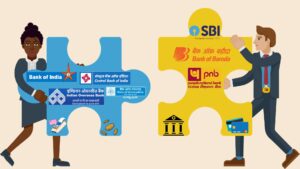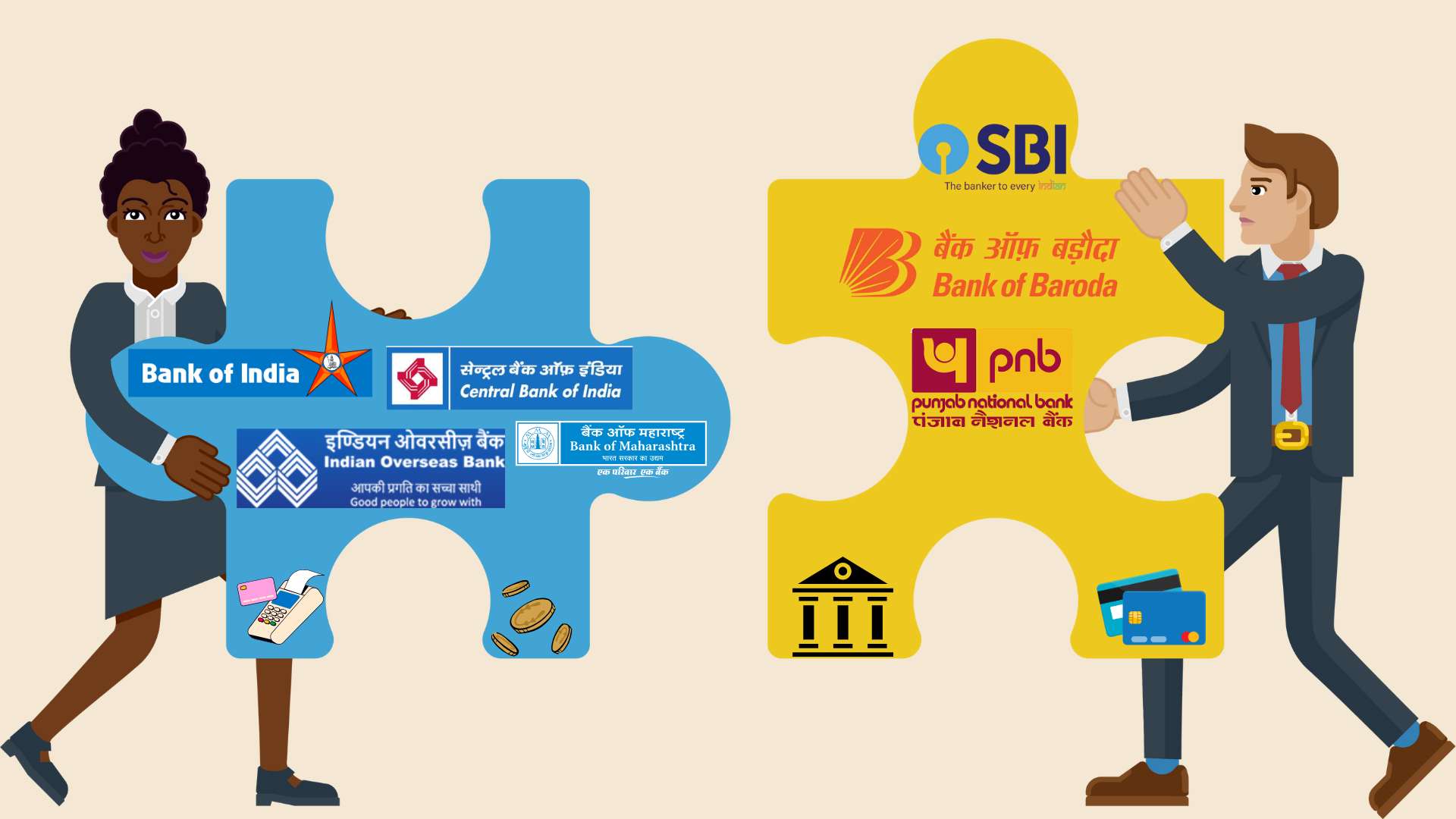 The Finance Minister has again started talking about the merger of 2–3 big banks to compete in the global market, and newspapers say that the government is considering the appointment of Managing Directors in public banks from the private sector. This will destroy Public Sector Banks. Privatisation is an affront to the Constitution. It will lead to disasters.
The Finance Minister has again started talking about the merger of 2–3 big banks to compete in the global market, and newspapers say that the government is considering the appointment of Managing Directors in public banks from the private sector. This will destroy Public Sector Banks. Privatisation is an affront to the Constitution. It will lead to disasters.
Let’s analyse each of the proposals:
The merger of 28 Public Sector Banks has led to the closure of branches, reduction in staff, and poor customer service. Private banks have used this as an opportunity to lure high-value customers by promising better service. This increase in the share of business of private sector banks is due to this and the expansion of their branches and staff.
| Category | 2014 | 2025 |
| PSBs | 8,42,813 | 7,48,707 |
| RRBs | 82,559 | 96,608 |
| Private Banks | 3,03,856 | 8,38,441 |
| Small Finance Banks | – | 1,81,712 |
| Payment Banks | – | 7,098 |
| Foreign Banks | 24,727 | 28,131 |
| Total | 12,53,955 | 19,00,697 |
In 2014, there were 9,25,372 (74%) employees in Public Sector Banks if Regional Rural Banks (RRBs) were added to PSBs. Along with foreign banks, private sector banks had only 3,28,583 (26%) of the total employees. 1,02,257 (84.5%) branches were with PSBs and 18,708 (15.5%) branches were with private banks.
88.2% of the deposit accounts and 78.8% of the deposits were with public banks. Private banks had 11.8% of the accounts and 21.2% of the deposits. Public Sector Banks had 70.9% of the loan accounts and 75.7% of the loan outstanding. Private banks had only 29.1% of the loan accounts and 24.3% of the loan outstanding.
In 2025, PSBs including RRBs employ 8,45,315 (45%). Private banks, including SFBs, FBs, and Payment Banks, employ 10,55,382 (55%). This is one indicator showing how private banks have grown and public banks have weakened. One should remember that there is no reservation policy for appointments in private banks.
Out of the total deposits of ₹2,39,06,3261 crores, public banks have ₹13,34,9808 crores, RRBs have ₹7,03,204 crores (₹14,04,8012 crores together), whereas private banks have ₹8,40,5190 crores, foreign banks have ₹11,07,624 crores, SFBs ₹3,15,390 crores, and payment banks ₹25,046 crores. So, 59% of the deposits (reduced from 78.8%) are with public banks and 41% with private banks as on March 2025. The number of deposit accounts serviced by public banks is 1,64,34,77,000 (69%) (reduced from 88.2%), and private banks is 7,46,78,5000 (31%). It’s clear that private banks serve the rich more, and public banks serve the poor more.
This happened only because of the policies of this government which has the RBI under its thumb.
Can Indian Banks Become Globally Competitive?
Never. Our per capita income is low. Our currency value is low. Our export is low and GDP is low. How can banks alone change that?
Per capita income of a few countries in terms of PPP is given below:
Singapore – $141,553; Norway – $100,668; USA – $82,268; Australia – $70,340; Germany – $69,027; UK – $58,273; Malaysia – $36,417; China – $24,569; and India – $10,666. Our per capita income is not even one-third of China’s and one-eighth of the USA’s. The top banks in terms of assets, market capitalisation, and customer base are Chinese and US banks.
GDP of China is 18,398,577 and that of the USA is 30,615,743. India’s GDP is 4,125,213 in $ terms—21% of China’s and 13% of the USA’s. How are you going to compete? Our share of exports is just 1.8% of global trade and imports 2.8%.
Why misguide the people, Madam Finance Minister?
Indian banks have enough to do in the country.
While India has 14 branches per one lakh population, the US has 138, Sweden 224, and South Africa 1,501.
Household loans per capita in India are $5,415, whereas in the US it is $104,500, Singapore $356,465, and Switzerland $257,429.
The bank deposits-to-GDP ratio in Hong Kong is 403%, US 101%, Japan 260%, Australia 112%, and in India it is 72%.
What is needed in India is more banks, more branches, more staff, and more loans, especially to the poor and middle class. Mergers have collapsed globally. A few examples are Credit Suisse and UBS, Deutsche Postbank and Deutsche Bank, and Wachovia and Wells Fargo. If the FM wants, let her merge ICICI, HDFC, and Axis. All were promoted by the government only. Public Sector Banks are not her private property—not even private banks.
Private Bank to Public Bank MDs
The Finance Minister should know what Chanda Kochhar did in ICICI Bank, Rana Kapoor in Yes Bank, and what happened to IL&FS and Dewan Housing, etc. Yes Bank was saved by SBI by sending Mr. Prashant Kumar, Dy. MD, as MD, and he saved the bank. Mr. Ramesh Kumar, Dy. MD, SBI, after retirement, is MD in Karur Vysya Bank, which he has taken to greater heights. While private banks are looking for Public Sector Bank executives to save their banks, is it not foolish to think of the opposite?
Privatisation Will Be a Peril
Different governments have tried to promote private banks in India. Global Trust Bank perished, Yes Bank perished, and IndusInd Bank is in turmoil. There were many which failed earlier. Once you privatise a Public Sector Bank, it will lose customers, and if more are privatised, one can be sure that you will take the country 30 years backward. On the ninth year of a disaster called demonetisation, I warn the FM and PM that this will be a bigger disaster.
Indian Bank, United Bank of India, and UCO Bank were considered weak and not provided wage revision. This led to the creation of the United Forum of Bank Unions, which is the apex body of award staff unions and officers’ associations. Today all three banks are doing well. UFBU is strong and it has given an ultimatum against privatisation, which it has stopped for 34 years. In 2017, the Finance Ministry classified 11 banks as weak banks. The All India Bank Officers’ Confederation submitted turnaround plans for each one of them based on their strengths, weaknesses, threats, and opportunities. All are doing well for the last five years or more.
Now that the government of the corporates, by the corporates, for the corporates wants excellent-performing public banks with huge profit and enormous assets valued at almost nil to be given to their cronies in the corporate sector (Indian and international), time has come for the United Forum to unite with the customers who will be affected and form a Mega United Forum. The youth of the country who will lose the reservation policy with privatisation will join hands. The women forced to go to Micro Finance Institutions will join hands. The MSMEs, farmers, and trade unions will join hands. Together we will save the country.
Thomas Franco is the former General Secretary of the All India Bank Officers’ Confederation and a Steering Committee Member at the Global Labour University.
Centre for Financial Accountability is now on Telegram and WhatsApp. Click here to join our Telegram channel and click here to join our WhatsApp channeland stay tuned to the latest updates and insights on the economy and finance.

